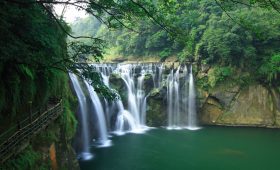Salar de Uyuni – Bolivia
Exploring the Unique Landscape
Salar de Uyuni, located in the Bolivian Altiplano, is the world’s largest salt flat, covering over 10,000 square kilometers. This vast expanse of white salt crystals creates a stunningly flat landscape, often used for vehicle testing due to its perfect levelness. During the dry season, the salt flats resemble a giant white canvas, offering endless opportunities for photography. The clear blue sky reflects off the salt crust, creating striking visual illusions.
In the rainy season, typically around January, the flats transform into a massive natural mirror. A thin layer of water covers the salt, reflecting the sky and creating a seamless horizon. This phenomenon is a breathtaking sight, making it difficult to distinguish where the sky ends and the earth begins.
When to Visit
The dry season, from May to October, is ideal for exploring the salt flats. During this time, the weather is generally pleasant, with clear skies and minimal rainfall. However, if you’re interested in witnessing the mirror effect, consider visiting during the rainy season from November to April. Be prepared for cooler temperatures and occasional rain, especially in January when flooding is most common.
Getting There
To reach Salar de Uyuni, most travelers fly into La Paz and then take a domestic flight to Uyuni. Alternatively, you can opt for a bus from La Paz to Uyuni, which is more budget-friendly but takes longer. The road conditions can be rough, so expect a bumpy ride. Tours often start in Uyuni, but you can also begin your journey from Tupiza or even San Pedro de Atacama in Chile, though the latter is more expensive.
Local Transportation
Once in Uyuni, the best way to explore the salt flats is by joining a guided tour. These tours, offered by various local agencies, range from single-day to multi-day excursions. They typically include transportation, accommodation, meals, and a knowledgeable guide. For those seeking independence, renting a 4×4 vehicle is an option, but navigating the flats without a guide is not recommended due to the challenging environment.
Notable Attractions
Incahuasi Island
In the heart of Salar de Uyuni lies Incahuasi Island, a volcanic rock formation covered with ancient cacti. These cacti, some over 1,000 years old, offer a unique contrast to the surrounding salt flats. The island provides panoramic views and is a great spot for photography.
Train Cemetery
Just outside Uyuni, the Train Cemetery is a haunting reminder of Bolivia’s railway history. This collection of abandoned steam locomotives from the early 20th century is a fascinating site for photographers and history enthusiasts alike.
Laguna Colorada
Located beyond the salt flats, Laguna Colorada is a striking red lake, colored by sediments and algae. It’s a haven for Andean flamingos, especially in November when three species flock to the area. The vibrant colors and wildlife make it a worthwhile addition to any itinerary.
Practical Tips
- Dress in layers to accommodate the fluctuating temperatures. Nights can be cold, with temperatures dropping as low as -9°C.
- Bring sunscreen, lip balm, and a hat to protect against the intense sun and high altitude.
- Choose a reputable tour operator to ensure a safe and enjoyable experience.
- Be prepared for altitude sickness, especially on multi-day tours that venture into higher altitudes.




